Sempte (©intava, SK) - 1573–1578
Detrekő (Plavecký hrad, SK) - 1579–1584
Rárbók (Rohoľník, SK) - 1584
Galgóc (Hlohovec, SK) - 1585–1588
Vizsoly - 1588–1599
|
The Foliopostilla by Péter Bornemisza (RMNy 541) and the Hungarian protestant Bible translation the Bible of Vizsoly (RMNy 652) are considered as the two greatest typographical achievements of the 16th century. The Foliopostilla is distinguished from the other printed sermons by Bornemisza by the folio size in which it was issued in the private printing shop of the author. The Szent Biblia (Holy Bible) was printed in the same although renewed printing shop inherited by Bornemisza's former companion who followed him as the owner of the office. This first edition of Szent Biblia is called the Bible of Vizsoly after its printing place. It was in this office moving several times during its activity of 25 years that the majority of Bornemisza's literary oeuvre as well as the first complete Hungarian (Protestant) Bible translation was produced.
Bornemisza was one of the protestant preachers and writers who were aware of the effect of printed word, just like his friend who shared both his literary ambitions and served similarly as a protestant priest. Bornemisza could realize his plan to have his sermons printed, in 1573, in the form of a shared enterprise with Gál Huszár. The two of them were probably acquainted while in Vienna where Gál Huszár learned printing in the office of Raphael Hoffhalter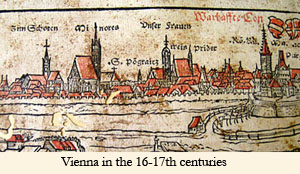 . It was here that their interest in setting up an own printing shop became manifest. It was in Vienna at that time (1558) that his first literary work the Hungarian adaptation of Elektra was printed (RMNy 144). As a protestant priest Bornemisza was in the service of prominent noble families in Upper Hungary, like the Balassa family, where he was also engaged as the teacher of the great poet Bálint Balassa. Later Bornemisza moved to Sempte (©intava, SK) to the estate of Count Julius Salm and his wife Erzsébet Thurzó. At the same time Gál Huszár was patronized by the Forgách family and served as a protestant preacher in Komjáti (Komjatice, SK). It is here that the printing shop shared by Huszár and Bornemisza was set up in 1573. It was not the first press established by Huszár, because he had certain remains of his former
. It was here that their interest in setting up an own printing shop became manifest. It was in Vienna at that time (1558) that his first literary work the Hungarian adaptation of Elektra was printed (RMNy 144). As a protestant priest Bornemisza was in the service of prominent noble families in Upper Hungary, like the Balassa family, where he was also engaged as the teacher of the great poet Bálint Balassa. Later Bornemisza moved to Sempte (©intava, SK) to the estate of Count Julius Salm and his wife Erzsébet Thurzó. At the same time Gál Huszár was patronized by the Forgách family and served as a protestant preacher in Komjáti (Komjatice, SK). It is here that the printing shop shared by Huszár and Bornemisza was set up in 1573. It was not the first press established by Huszár, because he had certain remains of his former 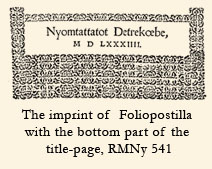 printing equipment active in Óvár, Kassa and Debrecen. To this old equipment certain new elements were added by Bornemisza, who purchased them from the Vienna office of Stainhofer.
printing equipment active in Óvár, Kassa and Debrecen. To this old equipment certain new elements were added by Bornemisza, who purchased them from the Vienna office of Stainhofer.
The oly relic of this cooperation of Huszár and Bornemisza is the first piece of the 5-volumes of Bornemisza' Sermons Shortly after it has left the press, the printing equipment was separated to two parts, thus two self-consistent printing shops were established, one was continued to work in Komjáti and the other, now directed by Bornimsza on his own, at Sempte. His printing work was helped by several apprentices. In the next ten years he awas almost entirely engaged in writing and printing his own sermons. To the fourth volume of these he annexed another work by him Ördögi kisértetek (Devil's Temptations), which 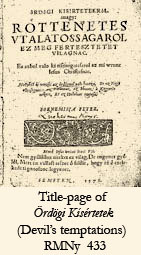 arose the anger of not only the Catholic church but also his patron count Julius Salm, who turned agins Bornemisza and refused to support him any longer. He had to leave Sempte in a hurry in December 1578 and 1579 found him already in the castle Detrekő (Plavecký hrad, SK) under the patronage of István Balassa. In his new place of activity his printing equipment was renewed: he bought new printing typies in Vienna. There is evidence that at Detrekő he had with him Bálint Mantskovit a s a printer and companion, but he might have worked with Bornemisza even earlier, perhasp in Sempte. He was probably of Polish origin and also used his name in Latinized form as Valentinus Farinola.
arose the anger of not only the Catholic church but also his patron count Julius Salm, who turned agins Bornemisza and refused to support him any longer. He had to leave Sempte in a hurry in December 1578 and 1579 found him already in the castle Detrekő (Plavecký hrad, SK) under the patronage of István Balassa. In his new place of activity his printing equipment was renewed: he bought new printing typies in Vienna. There is evidence that at Detrekő he had with him Bálint Mantskovit a s a printer and companion, but he might have worked with Bornemisza even earlier, perhasp in Sempte. He was probably of Polish origin and also used his name in Latinized form as Valentinus Farinola.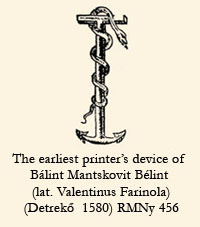
Taking the huge volumes of sermons written and printed by Bornemisza into consideration it can be stated that a aprinting activity of this dimensons was quite outstanding in contemporary Hungary. During his stay in the castle of Detrekö his greatest work was the writing and printing of Foliopostilla. With its reserved decoration and clear printing it is one of the finest Hungarian printed book in the 16th century. In the same year, 1584 Bornemisza died and it was after his death that the printing of Vigasztaló könyvecske (Consorting booklet) translated by the great Hungarian poet Bálint Balassi was finished. by Bálint Mantskovit the successor of Bornemisza. In 1585 Mantskovit moved to the nearby town Galgóc (Hlohovec, SK) where he continued his printing activity until 1588. We have to suppose a sort of companionship between Bornemisza and him, through which he came into the possession of Bornemisza's printing shop.
From the products of the workshop issued in Galgóc it is clear, that the printing equipment was significantly improving , new decorated alphabets and printing types appeared - those which are actually the types of the Vizsoly Bible. It is very likely that certain arrangements for the huge work were already made in Galgóc.
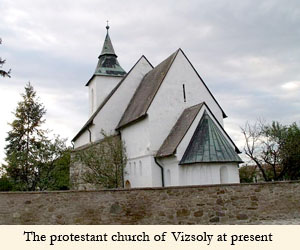 Vizsoly was in many respects more suitable for printing the Hungarian protestant Bible. It was not only to a considerable distance from Vienna but also closer to the market spot Gönc in Abaúj County, where the translator of the Bible Gáspár Károlyi was serving as a protestant priest. The landlords of Vizsoly the Rákóczi and Mágócsy family patronized and helped the printing of the protestant Bible, therefore they rendered a separate building for the purpuses of the printeing shop. As it can be read at the end of the Bible printing began on the 18th of February 1589 and it was finished on the 20th July 1590. (on the title-page 1590 Januar 10th is printed), i.e.
Vizsoly was in many respects more suitable for printing the Hungarian protestant Bible. It was not only to a considerable distance from Vienna but also closer to the market spot Gönc in Abaúj County, where the translator of the Bible Gáspár Károlyi was serving as a protestant priest. The landlords of Vizsoly the Rákóczi and Mágócsy family patronized and helped the printing of the protestant Bible, therefore they rendered a separate building for the purpuses of the printeing shop. As it can be read at the end of the Bible printing began on the 18th of February 1589 and it was finished on the 20th July 1590. (on the title-page 1590 Januar 10th is printed), i.e. 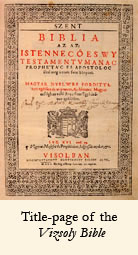 the printing took one and a half year. The huge volume consists of 603 sheets and the number of copies is supposed to have been 700 -800: this is the greatest printing achievement of the century in Hungary.
the printing took one and a half year. The huge volume consists of 603 sheets and the number of copies is supposed to have been 700 -800: this is the greatest printing achievement of the century in Hungary. 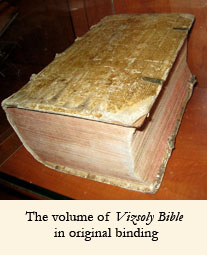 With this number of copies and in such a short time presumably four presses were needed to work parallelly.
With this number of copies and in such a short time presumably four presses were needed to work parallelly.
Not only the Bible, but other books were also issued in Vizsoly during the nine years it was active. It was still working in 1599, but there is no trace of further printing activity in Vizsoly. One can trace some pieces in the Vizsoly equipment which date back to the 1540s and 1550s.
The equipment of the Bornemisza-Mantskovit press consists of 24 printing types, 24 ornaments, calendar illustrations, decorated alphabets, a coat of arms of Hungary and four types of printer's devices used by Mantskovit. Of these the one representing anchor and serpent was exclusively used by Mantskovit, while the lamb resting on a book placed into a renaissance niche was further used in Bártfa well into the 17th century similarly to the crowned Hungarian coat of arms held by gryphons.
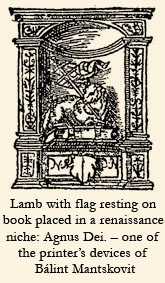 |
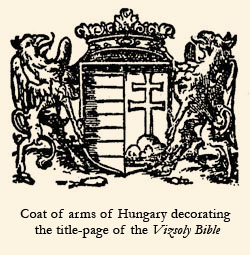 |
The oldest piece was the woodcut with the figure of Adam and Eve originating from the Sárvár-Újsziget press, used first in 1539 on the title-page of Grammatica, later used by Gál 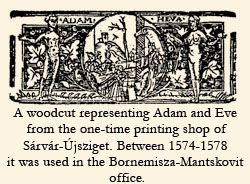 Huszár in Debrecen (1560) who transferred it to Bornemisza. It was the decorated alphabet with the floral background that was used for the longest time, from 1558 until the first decades of the 18th century.
Huszár in Debrecen (1560) who transferred it to Bornemisza. It was the decorated alphabet with the floral background that was used for the longest time, from 1558 until the first decades of the 18th century.
It is possible that Jakab Klöss -- the owner of the second press in Bártfa -- was present in Vizsoly when the Bible was printed. However, the former supposition that Klöss founded his printing whop in Bártfa from the equipment of Vizsoly, is not true. Both he and the other Bártfa printer David Gutgesell had printing equipments definitely differing from the Vizsoly one. It was only later in the 17th century that certain pieces from the Vizsoly press appeared in Bártfa.
Abbreviation::
RMNy
Régi magyarországi nyomtatványok – Res litteraria Hungariae
Vetus operum impressorum
1 (1473–1600),
2 (1601–1635),
3 (1636–1655).
Bp. 1971–2000


- Printing types - Ornaments - Illustrations - Decorated Initials - back to the top -


PRINTING TYPES


- Printing types - Ornaments - Illustrations - Decorated Initials - back to the top -


ORNAMENTS


- Printing types - Ornaments - Illustrations - Decorated Initials - back to the top -


ILLUSTRATIONS


- Printing types - Ornaments - Illustrations - Decorated Initials - back to the top -


DECORATED INITIALS


- Printing types - Ornaments - Illustrations - Decorated Initials - back to the top -
